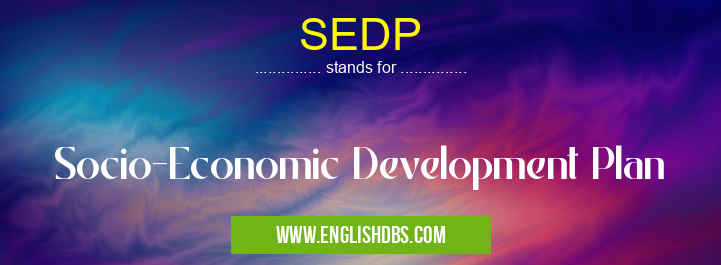What does SEDP mean in STATE & LOCAL
SEDP stands for Socio-Economic Development Plan. It is a comprehensive plan that outlines the strategies and programs for the social and economic development of a particular region or country. SEDPs are typically developed by government agencies or other relevant stakeholders, and they serve as a roadmap for achieving specific socio-economic goals.

SEDP meaning in State & Local in Governmental
SEDP mostly used in an acronym State & Local in Category Governmental that means Socio-Economic Development Plan
Shorthand: SEDP,
Full Form: Socio-Economic Development Plan
For more information of "Socio-Economic Development Plan", see the section below.
Key Elements of a SEDP
- Analysis of the existing socio-economic situation: This involves assessing the current state of the economy, social indicators, and other relevant factors.
- Identification of development goals and priorities: The plan should clearly define the desired outcomes and prioritize areas for intervention.
- Development of strategies and programs: This includes outlining specific actions and initiatives to achieve the identified goals.
- Resource allocation: The plan should specify the resources required for implementation, including financial, human, and technical resources.
- Monitoring and evaluation framework: The plan should include mechanisms for tracking progress and evaluating the effectiveness of the interventions.
Benefits of a SEDP
- Provides a coherent framework for socio-economic development.
- Facilitates coordination among different stakeholders involved in development.
- Enhances resource allocation and efficiency.
- Encourages accountability and transparency.
- Supports evidence-based decision-making.
Essential Questions and Answers on Socio-Economic Development Plan in "GOVERNMENTAL»LOCAL"
What is the Socio-Economic Development Plan (SEDP)?
The Socio-Economic Development Plan (SEDP) is a comprehensive framework that outlines a country or region's economic and social development goals and strategies. It typically covers a medium-term period (e.g., five to ten years) and serves as a blueprint for coordinated action among government agencies, private sector stakeholders, and civil society organizations.
What are the key elements of an SEDP?
Key elements of an SEDP typically include:
- Vision and mission statements
- Analysis of the current situation (economic, social, environmental)
- Goals and objectives
- Strategies and interventions
- Implementation plan
- Monitoring and evaluation framework
What are the objectives of an SEDP?
The objectives of an SEDP may vary depending on the specific context, but common goals include:
- Economic growth
- Poverty reduction
- Social equity
- Environmental sustainability
- Infrastructure development
- Public service improvement
Who is responsible for developing and implementing an SEDP?
The development and implementation of an SEDP is typically led by the government, often in collaboration with other stakeholders such as the private sector, civil society organizations, and international development partners.
What is the process for developing an SEDP?
Developing an SEDP typically involves the following steps:
- Situation analysis and needs assessment
- Stakeholder consultation and engagement
- Goal setting and strategy formulation
- Development of an implementation plan
- Monitoring and evaluation
How is an SEDP monitored and evaluated?
Monitoring and evaluation are crucial components of an SEDP. They involve tracking progress towards goals and objectives, identifying challenges, and making necessary adjustments to the plan. Monitoring typically focuses on short-term indicators, while evaluation assesses the overall impact and effectiveness of the plan over a longer period.
Final Words: SEDPs play a crucial role in guiding and facilitating socio-economic development. They provide a structured approach for addressing complex challenges and achieving desired outcomes. By engaging stakeholders, analyzing the current situation, setting clear goals, and implementing targeted interventions, SEDPs contribute to the sustainable and inclusive development of communities and nations.
